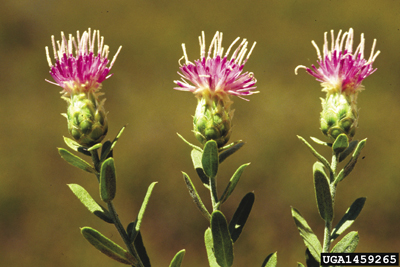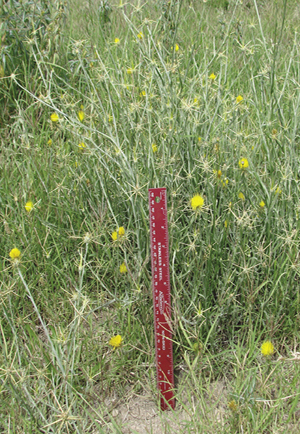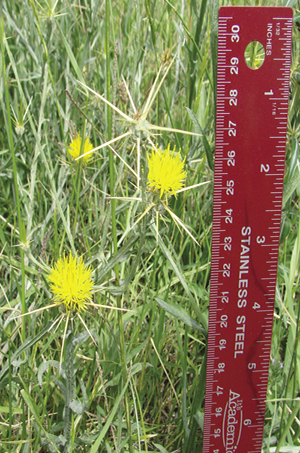Russian Knapweed and Yellow Star-Thistle Poisoning of Horses
Guide B-710
Revised by Jason L. Turner and Greg Alpers
College of Agricultural, Consumer and Environmental Science, New Mexico State University
Authors: Respectively, Professor/Extension Horse Specialist, Department of Extension Animal Sciences and Natural Resources (ASNR); and Interim Brush and Weed Specialist, ASNR, New Mexico State University. (Print Friendly PDF)
Introduction
Russian knapweed (Rhaponticum repens, formerly Centaurea repens or Acroptilon repens) and yellow star-thistle (Centaurea solstitialis) are unusual among poisonous plants in that they are toxic to horses—causing “chewing disease”—but cattle and sheep consume the plants without any apparent signs of toxicity. Since these two noxious weeds are aggressive invaders of pasture, range, and vacant lands in New Mexico, occasional poisoning of horses has been reported.
Description of Plants
Russian knapweed is a woody-stemmed perennial that grows to approximately 3 ft tall. It is characterized by gray hairs (knap) that cover its leaves and stems. The terminal branches of the stem give rise to purple thistle-like flowers (Figure 1).

Figure 1. Russian knapweed flowers. (Photo courtesy of Steve Dewey, Utah State University, Bugwood.org.)
Although it is not as prevalent as Russian knapweed, yellow star-thistle (Figure 2) is found in certain areas of New Mexico. It is an annual weed with multiple branching stems that yield characteristic star-like yellow flowers (Figure 3) protected by long, spiny bracts. It also grows to a height of approximately 3 ft.
Figure 2. Yellow star-thistle plants. (Photo courtesy of John O’Loughlin, Grant County Noxious Weed Program Coordinator.)
Figure 3. Yellow star-thistle flowers. (Photo courtesy of John O’Loughlin, Grant County Noxious Weed Program Coordinator.)
Toxic Principles
The exact chemical compound responsible for toxicity in Russian knapweed and yellow star-thistle has not been defined; however, a sesquiterpene lactone, repin, is believed to be the key neurotoxin present. The toxic effects of Russian knapweed and yellow star-thistle are cumulative, meaning that poisoning normally results when levels of the toxin build up in the body over time due to horses routinely grazing these plants.Horses must consume relatively large quantities of the green or dried plants before the toxic threshold is reached. It has been suggested that a horse must consume 60% of its body weight in green Russian knapweed plant material before toxicity symptoms appear. For yellow star-thistle, toxicity symptoms may arise after horses have ingested 85 to 100% of their body weight in green plant material. Once these thresholds are reached, disease symptoms have a rapid onset.
Symptoms
The clinical signs of poisoning observed in horses that have consumed large quantities of these plants result from accumulation of the toxin in the brain, resulting in necrosis, or death, of neural tissue. Initial symptoms of the disease include impaired ability to eat or drink, as well as anxious or confused behavior. In the following couple of days, the horse will begin showing the classic symptoms of hypertonicity (sustained contraction) of the muscles of the muzzle, lips, and tongue. The mouth may be held open or closed, with the tongue hanging out in a curled manner to form a “V” shape. This is accompanied by constant chewing-like motions of the mouth, which can injure the tongue and other mouthparts. During this stage of chewing disease, horses are unable to eat pasture or hay, but they are still able to swallow. Muscle paralysis means that they are unable to drink water in a normal fashion, and horses may learn to submerge their muzzles deeply so that water will flow into the esophagus, allowing it to be swallowed. Other abnormal behaviors observed include yawning, violent head tossing, drowsiness, and other locomotor impairments.If left untreated, horses normally die of starvation, dehydration, or inhalation pneumonia. Due to the irreversible neurological damage that occurs, euthanasia of afflicted animals is recommended.
Management: Prevention and Control Measures
Generally, these plants are not highly palatable to horses, so toxicity stems from horses being forced to eat Russian knapweed or yellow star-thistle because no suitable forage is available. Horse owners should monitor grazing conditions on their pastures or rangeland, and if they notice horses consuming these toxic plants, immediately remove the horses from the infected area and provide alternative forage. As part of a weed management program, herbicides such as those listed in Table 1 can be used to control Russian knapweed and yellow star-thistle.
Since clinical symptoms result from irreversible damage to brain tissue, the outlook for recovery of horses showing signs of poisoning is poor. If a horse survives, the owner can expect permanent impairment of the horse’s nervous system. Therefore, preventing consumption is the only certain means of preventing clinical symptoms and death.
|
Table 1. Herbicides Currently Labeled for Control of Russian Knapweed and Yellow Star-Thistle in Pastures and Rangeland1 |
|||
|
Common Name |
Trade Name |
Application Rate (amount/acre) |
Time of Application |
|
Russian Knapweed |
|||
|
Picloram |
Tordon 22K* |
1 to 2 qt |
Early flower to frost |
|
Clopyralid + 2,4-D |
Curtail |
1 to 2 qt |
Full bloom to frost |
|
Clopyralid |
Reclaim |
2/3 to 1 1/3 pt |
|
|
Imazapic |
Plateau |
12 oz |
Fall and winter |
|
Aminopyralid |
Milestone |
5 to 7 oz |
|
|
Chlorsulfuron |
Telar XP |
1 to 3 oz |
Prebloom to bloom and fall rosette |
|
Aminopyralid + metsulfuron |
Chaparral |
2 1/2 to 3 1/3 oz |
Spring or fall |
|
Aminopyralid + florpyrauxifen |
DuraCor |
16 oz |
Fall |
|
Aminopyralid + 2,4-D |
GrazonNext |
2.1 pt |
Fall |
|
Yellow Star-Thistle |
|||
|
Metsulfuron |
Escort XP |
1 oz |
Seedling to early bud |
|
Metsulfuron + 2,4-D + dicamba |
Cimarron MAX |
Rate III: 1 oz + 4 pt |
|
|
Dicamba + diflufenzopyr |
Overdrive |
4 oz |
Rosette |
|
Triclopyr |
Remedy |
3 pt |
Spring to early bud |
|
2,4-D |
Esteron 99 and others |
1 qt |
|
|
Imazapyr |
Arsenal |
1 pt |
|
|
Picloram |
Tordon 22k* |
1 pt |
|
|
Dicamba |
Banvel, Clarity |
1 pt |
|
|
Clopyralid |
Reclaim |
2/3 pt |
|
|
Picloram + 2,4-D |
Grazon P+D* |
2 qt |
|
|
Aminopyralid |
Milestone |
3 to 5 oz |
|
|
Aminopyralid + florpyrauxifen |
DuraCor |
16 oz |
|
|
Aminopyralid + 2,4-D |
GrazonNext |
2.1 pt |
|
|
Picloram + fluroxypyr |
Surmount* |
1.5 pt |
|
|
1Always follow the herbicide label, which supersedes this table. Some herbicides may injure non-target plant species and have use restrictions. *A pesticide applicator license may be required to purchase the product. Be sure to use adjuvants described on herbicide labels. Further control recommendations can be found in NMSU Extension Circular 597, Chemical Weed and Brush Control for New Mexico Rangelands (https://pubs.nmsu.edu/_circulars/CR597/). |
|||
References
Burrows, G.E., and R.J. Tyrl. 2001. Asteraceae Dumort. In Toxic plants of North America (pp. 156–160). Ames: Iowa State University Press.
Knight, A.P. 1995. Plant poisoning of horses. In L.D. Lewis (Ed.), Equine clinical nutrition: Feeding and care (pp. 466–467). Philadelphia: Williams and Wilkins.
USDA. 2017. Field guide for managing Russian knapweed in the Southwest [TP-R3-16-13]. USDA Forest Service, Southwest Region. Retrieved September 12, 2022, from https://www.fs.usda.gov/Internet/FSE_DOCUMENTS/fseprd563042.pdf
USDA. 2017. Field guide for managing yellow starthistle in the Southwest [TP-R3-16-07]. USDA Forest Service, Southwest Region. Retrieved September 12, 2022, from https://www.fs.usda.gov/Internet/FSE_DOCUMENTS/fseprd563051.pdf
Young, K., and C. Spackman. 2021. Chemical weed and brush control for New Mexico rangelands [Circular 597]. Las Cruces: New Mexico State University Cooperative Extension Service.
For further reading
B-709: Milkweed Poisoning of Horses
https://pubs.nmsu.edu/_b/B709/
B-712: Oleander Poisoning of Horses
https://pubs.nmsu.edu/_b/B712/
B-713: Locoweed Poisoning of Horses
https://pubs.nmsu.edu/_b/B713/
Spanish Translation | Traducción al Español
Original authors: Jason L. Turner, Extension Horse Specialist; Keith Duncan, Extension Weed and Brush Specialist; Jesse LeFevre, Jicarilla Apache Extension Agent.

Jason L. Turner is a Professor and Extension Horse Specialist. Jason was active in 4-H and FFA while growing up in Northeastern Oklahoma. His M.S. and Ph.D. studies concentrated on equine reproduction, health, and management. His Extension programs focus on proper care and management of the horse for youth and adults.
The pesticide recommendations in this publication are provided only as a guide. The authors and New Mexico State University assume no liability resulting from their use. Please be aware that pesticide labels and registration can change at any time; by law, it is the applicator’s responsibility to use pesticides ONLY according to the directions on the current label. Use pesticides selectively and carefully and follow recommended procedures for the safe storage and disposal of surplus pesticides and containers.
Brand names appearing in publications are for product identification purposes only. No endorsement is intended, nor is criticism implied of similar products not mentioned. Persons using such products assume responsibility for their use in accordance with current label directions of the manufacturer.
To find more resources for your business, home, or family, visit the College of Agricultural, Consumer and Environmental Sciences on the World Wide Web at pubs.nmsu.edu
Contents of publications may be freely reproduced for educational purposes. All other rights reserved. For permission to use publications for other purposes, contact pubs@nmsu.edu or the authors listed on the publication.
New Mexico State University is an equal opportunity/affirmative action employer and educator. NMSU and the U.S. Department of Agriculture cooperating.
Revised January 2023 Las Cruces, NM


